Views of Tenant Farmers and Agricultural Landlords on Aspects of the Agricultural Tenancy System
Results from surveys of tenant farmers and agricultural landlords on aspects of the tenancy system such as rent review, fixed equipment, diversification and tenancy relationships.
2 LEASES HELD
Summary
1. Eighty per cent of tenant farmers reported that they have only one lease of at least one year.
2. Landlords tended to rent out more than one lease of at least one year, with 60% having two or more.
3. Just over half (54%) of tenant farmers' main leases cover an area of less than 80 hectares, while for more than two-thirds (69%) of landlords the main tenant lease is for an area of less than 80 hectares (198 acres).
4. Tenant farmers are most likely to rent-in a whole farm, rather than land only or land with limited fixed equipment. Similarly, landlords were most likely to rent-out a whole farm.
5. Both tenant farmers and landlords reported that Secure 1991 Act tenancies were the most widely-used type of tenancy arrangement.
5. Tenant farmers with an LDT/SLDT were the subgroup most likely to have experienced some kind of change in tenure since 2000.
2.1 This section of the report looks in detail at the number and nature of leases rented-in by tenant farmers and rented-out by landlords, as well as the area covered by leases, the types of tenancy arrangements employed and use of other types of tenure, and whether there are any written records which relate to the lease.
Basic information on leases held
2.2 Not including seasonal lets, crofting or other arrangements, 80% of tenant farmers have one lease of more than one year, 16% have two, and 4% have three or more such leases (Figure 2.1). Of those landlords who reported that they have a lease of more than one year (299), 44% have one lease, 15% have two, and 41% have three or more leases.
Figure 2.1: Number of leases for more than one year
Tenant Farmers Q. Not including seasonal lets, crofts or crofting, or other types of informal arrangement, how many leases of more than one year does your farm business have?
Landlord Q. Not including seasonal lets on types of informal arrangement, how many leases of more than one year does your farm business have?
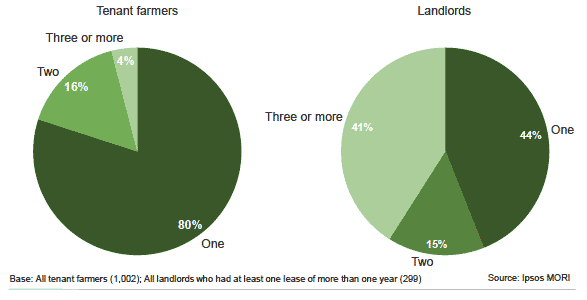
2.3 Tenant farmers who had more than one lease (20% of respondents) were asked how many landlords they have for these leases. Forty-two per cent reported having one landlord, and 46% said that they have two. Thirteen per cent had three or more landlords for leases of one year or more (Figure 2.2). In total, 88% of tenant farmers only dealt with one landlord.
Figure 2.2: Number of landlords for tenant farmers with multiple leases
Q. Overal, how many different landlords do you have for your leases?
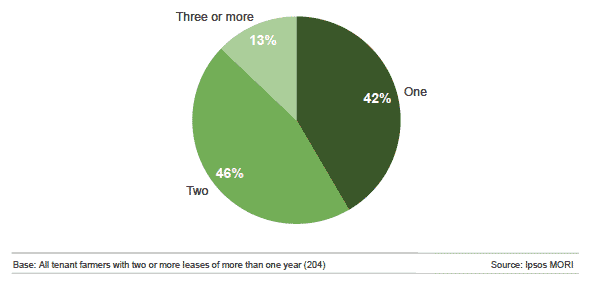
2.4 When asked to give more detail about the nature of leases held, 16% of tenant farmers had a lease for land only without any fixed equipment, 43% had a lease for land only and limited fixed equipment (such as fences and drainage), and 53% had a lease for a whole farm including fixed equipment (Figure 2.3). In contrast, among those landlords who gave an answer (namely those renting out with a lease of more than 1 year) 65% held a lease for land only without any fixed equipment, 76% had a lease for land only and limited fixed equipment, and 85% had a lease for a whole farm.
Figure 2.3: Types of leases held
Q. Which of the following type(s) of lease do you have?
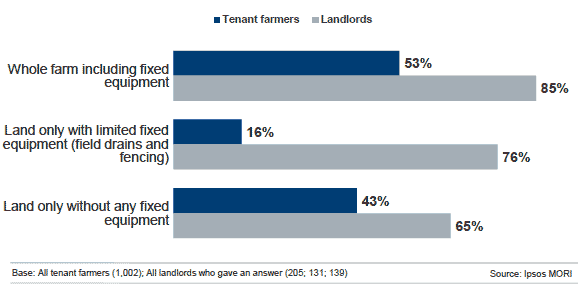
Seasonal lets
2.5 Forty per cent of tenant farmers in the sample rent-in land as a seasonal let[6], while 60% do not. Those whose main lease is a Limited Duration Tenancy (LTD) or a Short Limited Duration Tenancy (SLDT) (50%) were more likely to do this than those whose main lease is a Secure 1991 Act tenancy (40%) or another type of arrangement (31%). In addition, those tenant farmers with a livestock farm larger than 80 hectares (51%) and those with a mixed farm (47%) were more likely to rent-in land through a seasonal let than those with an arable (33%) or 'other' farm (28%).
2.6 One-fifth (18%) of tenant farmers rent-out land as a seasonal let, while 82% do not do this. Tenant farmers on 'other' (38%) and arable farms (32%) were more likely to rent-out seasonal lets than farms that are mixed (12%), non-LFA cattle and sheep (10%), and livestock farms larger (7%) and smaller than 80 hectares (7%).
2.7 Seventy per cent of landlords[7] who rent-out on at least one lease of more than one year and who answered the question reported that they also rent-out land as a seasonal let, while 30% reported that they do not rent-out seasonal lets[8]. Of these, 72% of landlords whose largest lease is a Secure 1991 Act tenancy (127 respondents) said that they rent-out land using seasonal lets.
2.8 Sixty per cent of those landlords who rent-out at least one lease of more than one year and who answered this question said that they own and farm land in-hand, including contract farming. The remaining 40% of landlords said that they did not do this.
Change in tenure since 2000
2.9 In order to understand the extent of changes in tenure in recent years, respondents to both surveys were asked if they had experienced any of a number of changes in tenure arrangements since 2000.
2.10 Questions asked about tenure change cannot be directly linked to different types of tenure held. Tenant farmers and landlords may hold more than one tenancy, and may have experienced more than one type of tenure change since 2000, it is therefore only possible to summarise broad patterns of change.
2.11 Among tenant farmers, 38% said that they had renewed a tenancy with the same landlord and same area since 2000, while 19% had inherited a tenancy through succession. Twelve per cent had taken out a tenancy for new land, and a similar proportion had been assigned a tenancy (12%) or expanded an existing tenancy by adding a parcel of new land (10%) (Figure 2.4).
2.12 Overall, 5% had lost a tenancy when a landlord chose not to renew it and 4% had decided not to renew a tenancy.
Figure 2.4: Tenant farmers' experience of tenure change since 2000
Q. Since 2000, have you experienced any of the following?
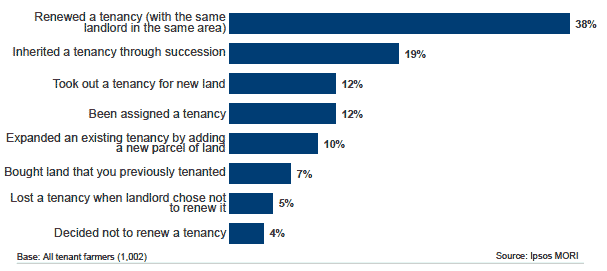
2.13 It is possible to analyse responses to these questions in relation to the type of lease held by tenant farmers for the main holding. As SLDTs and LDTs were introduced in new legislation in 2003, any tenant farmer with a SLDT or LDT has experienced a tenure change since 2000. Over and above this, tenant farmers with an LDT or SLDT as their main lease were more likely to have:
- Renewed a tenancy (68% with an LDT/SLDT, compared with 30% of those with a Secure 1991 Act tenancy and 34% of those with other arrangements),
- Taken out a tenancy for new land (29% compared with 9% and 7% respectively)
- Expanded an existing tenancy by adding a new parcel of land (19% compared with 7% and 8% respectively)
- Decided not to renew a tenancy (6% compared with 3% of those with a Secure 1991 Act tenancy).
2.14 In contrast, tenant farmers whose main tenancy was a Secure 1991 Act tenancy were most likely to have inherited a tenancy through succession (24% compared with 9% of those whose main lease is an LDT/SLDT and 8% of those with other types of arrangement).
2.15 Among all tenant farmers who have renewed a tenancy since 2000 (38% of respondents), 46% have a Secure 1991 Act tenancy as their main lease and 33% have a LDT/SLDT tenancy. In contrast, tenant farmers who have not renewed a tenancy since 2000 are more likely to have a Secure 1991 Act tenancy (67%) and less likely to have a LDT/SLDT tenancy (9%) as their main lease. Similarly:
- Those who have inherited a tenancy since 2000 are more likely to have a Secure 1991 Act tenancy for their main lease than those who have not inherited a tenancy (77% compared with 55%)
- Those who have taken out a tenancy for new land since 2000 are more likely to have a LDT/SLDT lease for their main tenancy than those who have not (43% compared with 15%). Additionally, they are less likely to have a Secure 1991 Act for their main tenancy (44% compared with 61%)
- Tenant farmers who have been assigned a tenancy since 2000 are more likely to have a Secure 1991 Act tenancy for their main lease than those who have not (67% compared with 58%)
- Those who have expanded an existing tenancy by adding a new parcel of land since 2000 are more likely to have an LDT/SLDT tenancy for their main lease than those who have not (37% compared with 16%) and less likely to have a Secure 1991 tenancy for their main lease (44% compared with 61%).
2.16 Among landlords who rent-out land on leases for more than one year (299 returned forms), around half (49%) who completed the questions on tenure change since 2000 had renewed a tenancy in the same area with the same tenant, while 46% had not experienced this (Figure 2.5). For each of the other types of tenure change, only minorities of landlords had experienced each: 29% had taken a tenancy back in-hand; 25% had leased out a new tenancy on a new area of their land; and 18% had expanded an existing tenancy by adding a new parcel of land.
Figure 2.5: Landlords' experience of types of tenure change since 2000
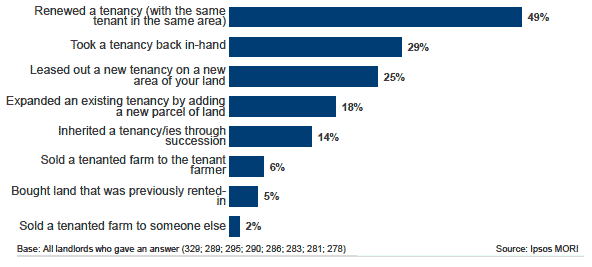
Area of land let
2.17 Both types of respondents were asked about the area of land that they rent-in or rent-out. More than half of tenant farmers (54%) rent-in an area of less than 80 hectares on their main lease, while 38% rent-in between 80 and 499 hectares, and 8% rent-in between 500 and 5,000 hectares (Figure 2.6). Tenant farmers with small livestock farms (35%), non-LFA sheep and cattle (63%), 'other' (61%), and mixed farms (53%) were more likely than those on arable farms (39%) to have a main lease of less than 80 hectares.
2.18 One-third (31%) of landlords who rent-out on leases of more than one year and who answered the question said that the largest lease that they rent-out is less than 80 hectares, while a further 43% have a largest lease of between 80 and 499 hectares, while 18% rent-out a largest lease of 500 hectares or more (Figure 2.6). Those whose main lease was an SLDT (57%) were more likely to have an area of under 80 hectares on this lease than those with an LDT (30%) or Secure 1991 Act tenancy (22%) whose leases were larger.
Figure 2.6: Area of main/only lease
Q. How many hectares does the (largest) lease cover?
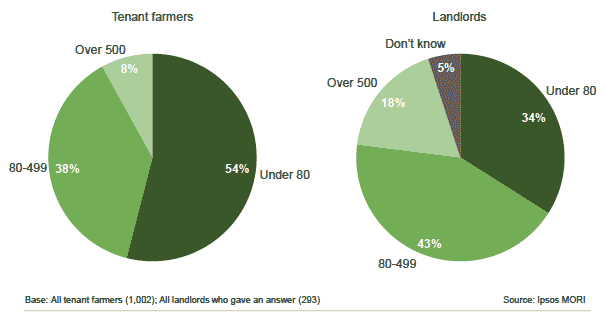
2.19 Among tenant farmers who have more than one lease, 71% rented in an area of less than 80 hectares on their second largest lease, while a quarter (27%) rented-in 80-499 hectares. In contrast, 20% of second-largest leases rented-out by landlords were under 80 hectares, while more than one-third of second leases were 80-499 hectares (35%), and 10% over 500 hectares. One-third (34%) of landlords did not provide an answer on the area of their second-largest lease (Figure 2.7).
Figure 2.7: Area rented-out on main and second-largest leases
Q. How many hectares does the second lease cover?
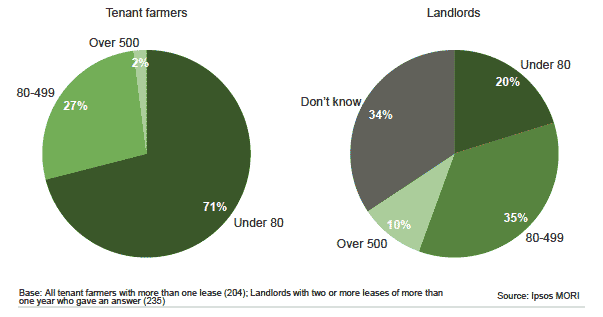
2.20 Table 2.1 shows the area of Secure 1991 Act tenancies rented-in by tenant farmers and rented-out by landlords. It shows that there is a difference[9] in the pattern of response between tenant farmers and landlords whose main or second leases are covered by a Secure 1991 Act tenancy.
Table 2.1: Area of Secure 1991 Act tenancies rented-in by tenant farmers and rented-out by landlords
Q. How many hectares does the (largest) lease/second lease cover?
| Area (hectares) | Tenant farmers | Landlords | ||
|---|---|---|---|---|
| Largest/only lease | Second largest lease | Largest/only lease | Second largest lease | |
| % | % | % | % | |
| Up to 20 | 37 | 48 | 5 | 5 |
| 20-50 | 30 | 34 | 9 | 8 |
| 50-100 | 18 | 13 | 14 | 16 |
| 100-200 | 7 | 2 | 21 | 32 |
| 200-500 | 4 | 2 | 24 | 19 |
| 500-1,000 | 3 | 0 | 8 | 13 |
| 1,000 or more | 1 | 0 | 20 | 7 |
| Base | 592 | 86 | 133 | 98 |
2.21 Tenant farmers whose main lease is covered by a Secure 1991 Act tenancy were most likely to report that this lease is up to 20 hectares in area (37%), between 20 and 50 hectares (30%), or between 50 and 100 hectares (18%).
2.22 There is a similar pattern among tenant farmers whose second-largest lease is a Secure 1991 Act tenancy: with half (48%) reporting that this lease covers an area of up to 20 hectares; one-third (34%) reporting that it is between 20 and 50 hectares; and 13% stating that the lease is between 50 and 100 hectares.
2.23 In contrast, landlords whose largest lease is a Secure 1991 Act tenancy were most likely to report that this lease covers an area of more than 1,000 hectares (20%), between 200 and 500 hectares (24%), between 100 and 200 hectares (21%), or between 50 and 100 hectares (14%).
2.24 A broadly similar pattern was found among landlords' second largest leases covered by a Secure 1991 Act tenancy: 13% stated that such a second lease covered an area of between 500 and 1,000 hectares; 19% were for an area of between 200 and 500 hectares; one-third were between 100 and 200 hectares; and 16% of second leases covered by a Secure 1991 Act tenancy were over an area of 50-100 hectares.
Length of tenure
2.25 One-fifth (19%) of tenant farmers have a main lease which began in 2005-2014, with a quarter (23%) having one beginning in 1990-2004, a further quarter (26%) beginning in 1965-1989, and a third (32%) pre-1964 (Figure 2.8).
2.26 There was a slightly different pattern in the tenure of second leases with second leases tending to be more recent. More than one-third (35%) of tenant farmers had a second largest lease starting in 2005-2014, and a further 27% of tenant farmers had a second largest lease starting in 1990-2004. However, some second leases had been held for a substantial time with one-fifth (20%) reporting that their second lease began between 1965 and 1989, and 18% starting before 1964.
Figure 2.8: Length of tenure on rented-in land
Q. When did the (largest) lease start?
Q. When did the second lease start?
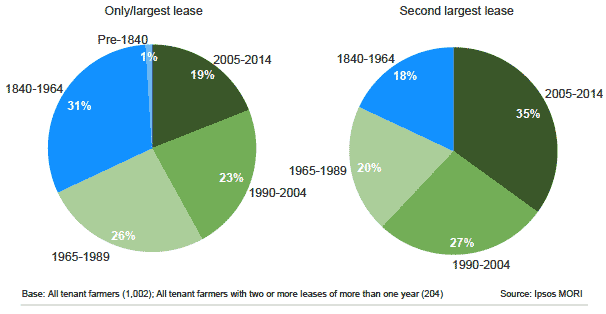
2.27 There were marked differences in length of tenure by tenant farmers' main lease type. Those with a Secure 1991 Act tenancy were most likely to have started their lease in 1840-1964 (45%) or 1965-1989 (32%), while those with an LDT/SLDT were most likely to have started their main tenancy since 2005 (64%), and respondents with other types of tenancy arrangement were most likely to have started their main lease in 1990-2004 (44%) (Table 2.2). Given that LDTs and SLDTs were first introduced in 2003 legislation, some tenant farmers who have an LDT/SLDT have answered with respect to the start of their tenure on the land rather than the start of their current lease. As a result, the reporting of LDTs/SLDTs starting in the period 1840-2004 is likely to be as a result of some tenant farmers misinterpreting the question.
Table 2.2: Tenant farmers' view on the length of tenure by type of tenancy
Q. When did your (main) lease start?
| Secure 1991 Act tenancy | LDT/SLDT | Other types | |
|---|---|---|---|
| % | % | % | |
| 2005-2014 | 7 | 64 | 10 |
| 1990-2004 | 16 | 29 | 44 |
| 1965-1989 | 32 | 6 | 30 |
| 1840-1964 | 45 | 2 | 14 |
| Pre 1840 | 1 | 0 | 2 |
| Base | 593 | 187 | 131 |
2.28 A similar overall pattern of tenure was found in the survey of landlords. A quarter (24%) of main leases rented-out began since 2005, with a quarter (24%) starting from 1990-2004, 21% from 1965-1989, and a quarter (23%) pre-1965 (Figure 2.9).
Figure 2.9: Length of tenure on rented-out land
Q. When did the (largest) lease start?
Q. When did the second lease start?

2.29 Twenty-two per cent of second leases rented-out began in 2005-2014, with 10% in 1990-2004, 15% in 1965-1989, and a quarter (26%) pre-1965. A quarter of landlords (27%) were unable to provide information for the start of their second lease.
Lease types
2.30 Among tenant farmers, the lease type of the majority (59%) of only/largest leases was a Secure 1991 Act tenancy[10], while one in ten had an SLDT (11%), LDT (8%) or a 1991 Act Limited Partnership (8%). Two-fifths (42%) of second largest leases were Secure 1991 Act tenancies, while over a quarter (28%) were reported to be SLDTs and 14% LDTs (Figure 2.10).
Figure 2.10: Type of tenancy of leases rented-in by tenant farmers
Q. What type of lease is the (largest) lease?
Q. What type of lease is the second lease?
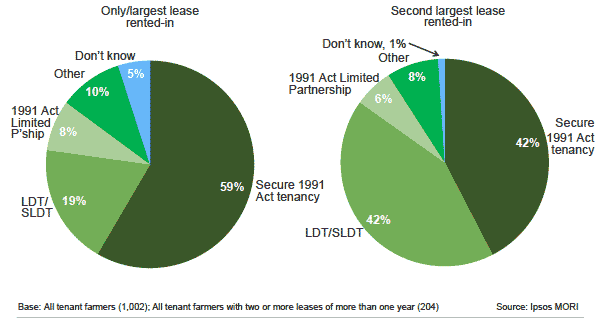
2.31 Slightly fewer landlords than tenant farmers reported that the main lease they rented-out was a Secure 1991 Act tenancy (48%), with 16% saying that their main lease was an SLDT, 11% an LDT, and 11% a 1991 Act Limited Partnership. Fifty-nine per cent of those landlords with more than one lease had a Secure 1991 Act tenancy on their second lease while one-fifth (18%) had an SLDT on this lease and 6% had an LDT (Figure 2.11)[11].
Figure 2.11: Type of tenancy of leases rented-out by agricultural landlords
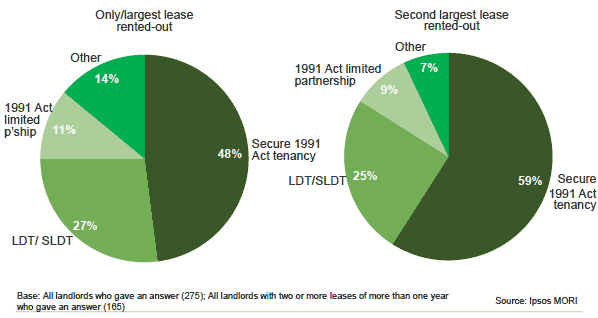
Written records in relation to the lease
2.32 Eighty-five per cent of tenant farmers and 85% of landlords said that they have a written agreement for their largest lease, while 12% of tenant farmers and 11% of landlords do not have a written agreement (Table 2.3).
Table 2.3: Written records in relation to largest/only lease[12]
| Tenant farmers | Landlords | |||
|---|---|---|---|---|
| Yes | No | Yes | No | |
| % | % | % | % | |
| Do you have/It there a written agreement for this lease? | 85 | 12 | 85 | 11 |
| Is this lease registered in the Book of Council and Session? | 52 | 12 | 37 | 28 |
| Do you have/Is there a record of condition? | 55 | 32 | 31 | 53 |
| Did you have/Was there the record of condition at the start of the tenancy? | 52 | 29 | 31 | 45 |
| Base | 1,002 | 284; 287; 288; 284 | ||
2.33 Tenant farmers whose main lease is an LDT/SLDT (97%) were more likely than those with a Secure 1991 Act tenancy (84%) or another arrangement (87%) to have a written agreement for their main lease. Similarly, those whose landlord is a company (92%) were more likely to have a written lease than those whose landlord is an individual or family business (82%).
2.34 Half (52%) of tenant farmers and 37% of landlords said that the lease is registered in the Books of Council and Session held by Registers of Scotland[13], while 12% of tenant farmers and 28% of landlords said that the lease is not registered and more than one-third (36%) did not know.
2.35 More than half (55%) of tenant farmers and 31% of landlords said that they have a record of condition for their lease. One-third (32%) of tenants said that they do not have a record of condition, as did 53% of landlords. Thirteen per cent of tenant farmers said that they did not know if there was a record of condition for their lease, and 15% of landlords said that they did not know or that this did not apply.
2.36 Around half (53%) of tenant farmers and 31% of landlords reported that the record of condition was available at the start of the tenancy, while for 28% of tenants and 45% of landlords it was not. One in five (20%) tenant farmers and 24% of landlords responded that they did not know.
2.37 Tenant farmers with an LDT/SLDT were more likely than those with a Secure 1991 Act tenancy to have a record of condition (68% compared with 53% respectively), and to have had the record of condition at the start of the tenancy (65% compared with 49%).
Contact
Email: Liz Hawkins
There is a problem
Thanks for your feedback